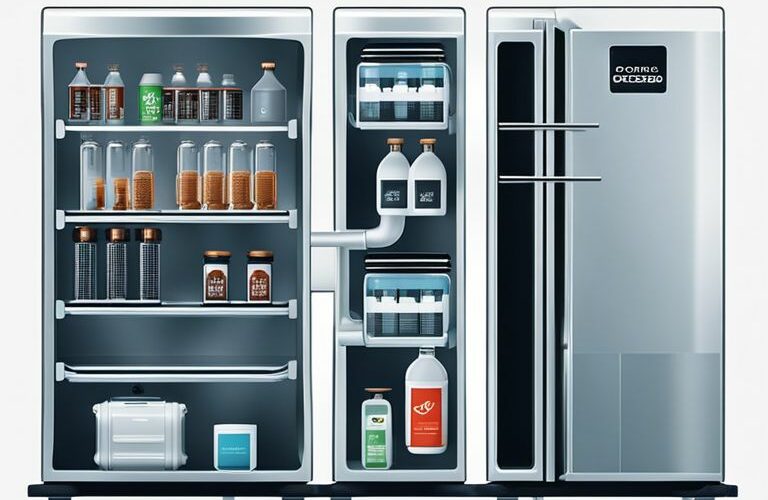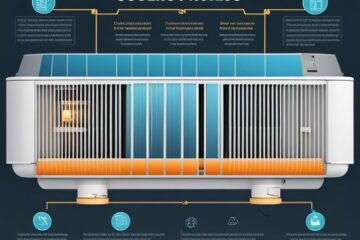The refrigerator, a common appliance found in nearly every household, operates on a fascinating principle of thermodynamics. Refrigerators work by transferring heat from the inside of the unit to the outside, utilizing a circulating system of refrigerant, compressor, condenser, and evaporator. This process allows them to maintain a consistently cool temperature for preserving food and drinks.
Refrigerators ensure the safety of our food by slowing down the growth of bacteria and mold, which thrive in warmer environments. It’s important to note that while fridges are incredibly convenient and crucial in modern-day living, they also pose a significant hazard if not properly maintained, as leaks or malfunctions in the refrigerant system can release harmful chemicals into the air. Understanding the basic mechanics of how a fridge works can help us appreciate and care for this crucial appliance in our homes.
Key Takeaways:
- Refrigerant cycle: The fridge works by using a refrigerant cycle to transfer heat from the inside of the fridge to the outside, keeping the inside cool.
- Compressor: The compressor is the heart of the fridge and is responsible for pumping the refrigerant through the system.
- Condenser coils: These coils are located on the back or bottom of the fridge and release heat into the surrounding air.
- Evaporator coils: These coils are located inside the fridge and absorb heat from the interior, keeping the contents cool.
- Thermostat: The thermostat controls the temperature inside the fridge by turning the compressor on and off as needed.
- Door seals: Properly functioning door seals are crucial for maintaining the efficiency of the fridge by keeping the cold air inside.
- Regular maintenance: Cleaning the coils, checking the door seals, and ensuring proper ventilation around the fridge are important for optimal performance and energy efficiency.
Fundamental Principles of Refrigeration
There’s no denying the integral role that refrigerators play in our daily lives, but have you ever stopped to wonder how exactly they work? The answer lies in the fundamentals of refrigeration, a process that involves the transfer of heat to keep our food and beverages cold.
Basic Concepts of Heat Transfer
Transfer of heat is at the core of how refrigerators operate. Heat naturally flows from areas of higher temperature to areas of lower temperature. In the case of a refrigerator, this heat transfer is manipulated to ensure that the interior of the fridge stays cold, while the heat is expelled outside. This is achieved through the use of refrigerants, gases or liquids that are able to absorb and release heat efficiently.
The Refrigeration Cycle Explained
Any refrigerator operates on the principle of a refrigeration cycle, which is a continuous process that allows for the cooling of the interior space. The cycle starts with the refrigerant entering the compressor as a low-pressure gas, where it is compressed into a high-pressure gas. This compression causes the temperature of the gas to rise significantly. The hot, high-pressure gas then flows through the condenser coils, located on the back or bottom of the fridge, where it releases heat to the surrounding environment.
Subsequently, the refrigerant moves into the expansion valve, where it undergoes a rapid pressure drop and becomes a cold, low-pressure liquid. This expansion results in a significant temperature decrease, allowing the refrigerant to absorb heat from the interior of the fridge. The cycle then repeats itself to maintain a consistently cool temperature inside the refrigerator.
Main Components of a Refrigerator
Compressor
One of the main components of a refrigerator is the compressor. This component is responsible for compressing the refrigerant gas, increasing its pressure and temperature. The compressor plays a crucial role in the refrigeration cycle by pumping the refrigerant through the system.
Condenser Coils
Compressor condenser coils play a vital role in dissipating heat from the refrigerant gas, turning it into a high-pressure liquid. These coils are usually located on the back or bottom of the refrigerator and are responsible for releasing the heat absorbed from the interior of the fridge into the surrounding air.
The condenser coils need to be kept clean to ensure proper heat transfer and efficient cooling. A buildup of dust and dirt can hinder the coils’ ability to release heat, causing the refrigerator to work harder and consume more energy.
Expansion Valve
An expansion valve is another vital component in the refrigeration cycle. This valve regulates the flow of the high-pressure liquid refrigerant into the evaporator coils, where it undergoes a sudden drop in pressure, causing it to evaporate and absorb heat from the refrigerator’s interior.
Evaporator Coils
Expansion Evaporator coils are where the magic happens in a refrigerator. These coils are responsible for absorbing heat from the interior of the fridge, causing the refrigerant to evaporate and cool the inside of the appliance. The evaporator coils are typically located inside the refrigerator or freezer compartments.
To ensure optimal cooling performance, it is important to keep the evaporator coils free of ice or frost buildup. Excessive ice formation can insulate the coils, reducing their efficiency and causing the refrigerator to run longer to maintain the set temperature.
Refrigerant
To maintain the cooling cycle, refrigerant plays a crucial role in absorbing and releasing heat as it circulates through the compressor, condenser coils, expansion valve, and evaporator coils. Common refrigerants used in modern refrigerators include HFCs (hydrofluorocarbons) and HCs (hydrocarbons).
It is important to handle refrigerants with care as they can be harmful to the environment if released into the atmosphere. Proper disposal and handling procedures should be followed to prevent environmental damage.
The Role of Refrigerants
After the refrigerator was invented, the next crucial component to understand is the role of refrigerants. Refrigerants are the lifeblood of a fridge, responsible for absorbing and releasing heat to keep the internal temperature cold. Without refrigerants, our refrigerators would not be able to function properly.
Types of Refrigerants
- CFCs (Chlorofluorocarbons): Used in older refrigerators, CFCs have been found to deplete the ozone layer.
- HFCs (Hydrofluorocarbons): Developed to replace CFCs, HFCs are now being phased out due to their high global warming potential.
- HFOs (Hydrofluoroolefins): The latest generation of refrigerants, HFOs are designed to have a lower impact on the environment.
- Ammonia and CO2: Natural refrigerants that are becoming more popular due to their eco-friendly properties.
- Blends: Mixtures of different refrigerants that aim to optimize performance while reducing environmental harm.
Perceiving the differences between these refrigerants is crucial in making informed decisions regarding environmental impact and efficiency.
| CFCs | Deplete ozone layer |
| HFCs | High global warming potential |
| HFOs | Low impact on environment |
| Ammonia and CO2 | Eco-friendly properties |
| Blends | Optimize performance and reduce harm |
Environmental Impact of Refrigerants
Any discussion on refrigerants must address their environmental impact. The gases used as refrigerants have varying effects on the environment, from ozone depletion to global warming potential. It is crucial to consider these factors when choosing a refrigerant for a fridge or any cooling system.
Another important aspect to consider is the phase-out of harmful refrigerants. Governments and organizations worldwide are working towards phasing out refrigerants that have a high impact on the environment. This shift towards eco-friendly refrigerants is a positive step in reducing the carbon footprint of refrigeration systems and protecting the planet for future generations.
Thermodynamics Behind the Fridge
Now, let’s examine into the thermodynamics principles that make your fridge function effectively.
Laws of Thermodynamics in Refrigeration
Laws of thermodynamics govern how heat moves in and out of a refrigeration system. The first law states that energy cannot be created or destroyed, only transferred or converted. In refrigeration, this means that the heat removed from the interior of the fridge is transferred to the coils on the back, where it is released into the surrounding air. The second law of thermodynamics dictates that heat naturally flows from hot to cold areas, which is the fundamental principle behind how a fridge keeps your food cold.
Pressure-Temperature Relationship
On a molecular level, temperature is directly related to the average kinetic energy of the particles in a substance, while pressure is a measure of the force exerted by these particles on the walls of their container. The pressure-temperature relationship in refrigeration systems is crucial for the refrigerant to absorb and release heat effectively. As the refrigerant circulates through the fridge’s system, it undergoes changes in pressure and temperature to facilitate the heat transfer process.
| Temperature | Pressure |
| Low temperature | Low pressure |
| High temperature | High pressure |
Plus, understanding the pressure-temperature relationship is crucial for maintaining the efficiency and safety of the refrigeration system. Incorrect pressure levels can lead to system malfunctions, reduced cooling capacity, or even potential hazards such as leaks or component failures.
Energy Efficiency and Modern Innovations
Energy Star Ratings and What They Mean
Many people are becoming increasingly conscious of the energy efficiency of their appliances, including refrigerators. Energy Star ratings are an important factor to consider when purchasing a new fridge. These ratings are provided by the Environmental Protection Agency (EPA) and indicate that the appliance meets certain criteria for energy efficiency. The higher the Energy Star rating, the more energy-efficient the refrigerator is. This not only helps to reduce your carbon footprint but also saves you money on your electricity bills.
Technological Advancements in Refrigeration
To keep up with the growing demand for energy-efficient appliances, manufacturers are constantly working on technological advancements in refrigeration. These innovations focus on improving the overall performance of the fridge while minimizing its energy consumption. From improved insulation to advanced compressor technology, modern refrigerators are designed to be more efficient than ever before.
With technological advancements in refrigeration, consumers can now enjoy features like smart sensors that adjust the temperature based on usage patterns, as well as energy-saving modes that help reduce power consumption during off-peak hours. These innovations not only benefit the environment but also provide users with greater convenience and savings in the long run.
Maintenance and Troubleshooting
Regular Maintenance Tips
Keep your fridge running efficiently with these regular maintenance tips. Clean the coils at least twice a year to ensure optimum performance and energy efficiency. Check the door seals for any signs of wear and tear, and replace them if necessary. Defrost the freezer regularly to prevent ice buildup, which can impact the cooling efficiency of the appliance. Make sure to keep the interior clean and organized to allow for proper air circulation.
- Regular maintenance can extend the lifespan of your fridge and prevent costly repairs down the line.
- Knowing how to care for your appliance properly can save you time and money in the long run.
Common Refrigerator Problems and Solutions
For common refrigerator problems and solutions, being aware of warning signs can help you address issues before they escalate. If your fridge is not cooling properly, check the temperature settings and clean the condenser coils. A leaking fridge may indicate a clogged defrost drain, which can be cleared with hot water and a cleaning tool. Odd noises coming from the appliance could be due to a malfunctioning evaporator fan or a faulty compressor.
Maintenance plays a crucial role in preventing major breakdowns and ensuring the efficiency of your fridge. It is important to address any issues promptly to avoid food spoilage and potential health risks from consuming improperly stored food.
To wrap up
So, understanding how a fridge works involves the transfer of heat through a process known as refrigeration. By using a refrigerant, compressor, condenser, expansion valve, and evaporator, fridges are able to maintain a cool environment to keep food fresh. The refrigerant cycles through these components, absorbing heat from the interior of the fridge and releasing it outside, creating a continuous cooling effect.
Modern refrigerators are efficient and reliable appliances that have become crucial in our daily lives. By grasping the basic principles of refrigeration, we can appreciate the technology behind these machines and how they play a vital role in preserving our food and extending its shelf life. So, next time you grab a cold drink from your fridge, remember the intricate process happening inside to keep it chilled and ready for you to enjoy.
FAQ
Q: How does a fridge work?
A: A fridge works by using a refrigeration cycle to transfer heat from inside the fridge to the outside, keeping the interior cool.
Q: What is the refrigeration cycle?
A: The refrigeration cycle consists of compressing and expanding a refrigerant gas to absorb and release heat, creating a cooling effect.
Q: What is the role of the compressor in a fridge?
A: The compressor in a fridge compresses the refrigerant gas, raising its temperature and pressure so it can release heat outside the fridge.
Q: How does the evaporator work in a fridge?
A: The evaporator in a fridge absorbs heat from the interior, cooling the air inside as the refrigerant evaporates and changes from a liquid to a gas.
Q: What is the purpose of the condenser in a fridge?
A: The condenser in a fridge releases the heat from the refrigerant gas to the surrounding environment, allowing the gas to return to a liquid state.
Q: How does the expansion valve function in a fridge?
A: The expansion valve in a fridge regulates the flow of the refrigerant, creating a pressure difference that facilitates the cooling process in the evaporator.
Q: What are some common issues that can affect a fridge’s cooling efficiency?
A: Common issues that can impact a fridge’s cooling efficiency include a malfunctioning compressor, clogged condenser coils, low refrigerant levels, or a faulty thermostat.









